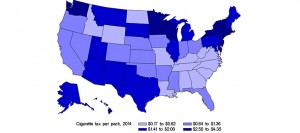
In states that enacted higher taxes on cigarettes and stricter policies on smoking in public places, suicide rates declined up to 15 percent compared to the national average, a new study shows.
“Our analysis showed that each dollar increase in cigarette taxes was associated with a 10 percent decrease in suicide risk,” says Richard A. Grucza, associate professor of psychiatry at Washington University in St. Louis. “Indoor smoking bans also were associated with risk reductions.”
Grucza and colleagues analyzed data compiled as individual states took different approaches to taxing cigarettes and limiting when and where people could smoke from 1990 to 2004.
The opposite was true in states with lower cigarette taxes and more lax policies toward smoking in public. In those states, suicide rates increased up to 6 percent, relative to the national average, during the same time period. From 1990 to 2004, the average annual suicide rate was about 14 deaths for every 100,000 people.
“States started raising their cigarette taxes, first as a way to raise revenue but then also as a way to improve public health,” Grucza says. “Higher taxes and more restrictive smoking policies are well-known ways of getting people to smoke less.
“So it set a natural experiment, which shows that the states with more aggressive policies also had lower rates of smoking. The next thing we wanted to learn was whether those states experienced any changes in suicide rates, relative to the states that didn’t implement these policies as aggressively.”
SMOKING-SUICIDE LINK
Suicide is the tenth leading cause of death in the United States, according to the Centers for Disease Control and Prevention. In 2010, nearly 40,000 people died of suicide across the nation.
Every death that occurs in the United States is recorded in a database managed by the National Center for Health Statistics. The researchers classified each suicide death based on the state where the victim had lived, as well as how aggressive that state’s tobacco policies were.
For the study published in Nicotine & Tobacco Research, scientists used statistical methods to compare rates of suicide in states with stricter tobacco policies to rates in states with more lenient laws and lower taxes. They also determined whether people who had committed suicide were likely to have smoked.
They learned that suicide risk among people most likely to smoke was associated with policies related to tobacco taxes and smoking restrictions.
“If you’re not a smoker, or not likely ever to become a smoker, then your suicide risk shouldn’t be influenced by tobacco policies,” Grucza says. “So the fact that we saw this influence among people who likely were smokers provides additional support for our idea that smoking itself is linked to suicide, rather than some other factor related to policy.”
BLAME NICOTINE?
Although scientists have known for years that people who smoke have a higher risk for suicide, they had assumed the risk was related to the psychiatric disorders that affect many smokers. These new findings, however, suggest smoking may increase the risk for psychiatric disorders, or make them more severe, which, in turn, can influence suicide risk.
“We really need to look more closely at the effects of smoking and nicotine, not only on physical health but on mental health, too,” Grucza says. “We don’t know exactly how smoking influences suicide risk. It could be that it affects depression or increases addiction to other substances. We don’t know how smoking exerts these effects, but the numbers show it clearly does something.”
Many states still have low cigarette taxes, while other states haven’t adopted comprehensive smoke-free air policies. Grucza predicts that if these states raise their cigarette taxes and restrict smoking in public, their suicide rates will likely fall.
Nicotine may be an important influence on suicide risk. Based on the study’s results, Grucza says he is concerned that many new restrictions on public smoking don’t cover newer e-cigarettes, which deliver nicotine but release vapor rather than smoke. This mechanism purportedly allows those addicted to nicotine to get a “fix” without affecting the air others breathe.
“Nicotine is a plausible candidate for explaining the link between smoking and suicide risk,” Grucza says. “Like any other addicting drug, people start using nicotine to feel good, but eventually they need it to feel normal. And as with other drugs, that chronic use can contribute to depression or anxiety, and that could help to explain the link to suicide.”
The American Foundation for Suicide Prevention, the National Institute on Drug Abuse, the National Cancer Institute, and the American Cancer Society funded the study.








